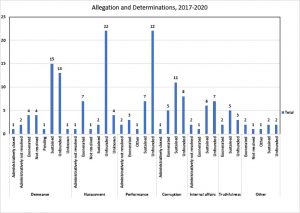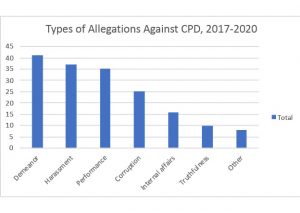On July 8, Charlottesville police officers responded to a citizen report of a man lying down drunk on the street outside CVS on the Downtown Mall.
Body camera footage reveals that the police officer, whose identity has not been publicly released, told the man, homeless 36 year old Christopher Gonzalez, “If you can stay off the Downtown Mall and I don’t see you again, then I won’t take you [to jail].”
Gonzalez declined and the officer attempted to put Gonzalez in handcuffs. Gonzalez then jerked his arm away.
The officer threw Gonzalez against the wall of CVS, kneed him in the thigh, and brought Gonzalez to the ground in what appeared to be a headlock. He held him there for 50 seconds before more officers arrived at the scene.
An Instagram video of the encounter later went viral and sparked widespread community outrage.
The incident is under investigation by Charlottesville PD’s internal affairs division.
Gonzalez is facing misdemeanor charges for disorderly conduct and intoxication in public, as well as felony assault on an officer.
The Nation and the Commonwealth
In a 2018 report, the U.S. Commission on Civil Rights found that some communities are unable to trust the police due to excessive force exhibited by police officers in their neighborhoods.
They have called for “additional policies, procedures, training and accountability measures in departments and the justice system, to foster better community-police relations and prevent excessive uses of force.”
The report also found that because there is no national database for police misconduct, there is no way to examine excessive force used in policing at a national level. The report did find that “the best available data reflects high rates nationally, with an increased likelihood that police will use force against people of color, people with disabilities, and LGBT individuals… combined with a lack of accurate data, transparency, and accountability, foster a perception that police use of force in these communities is unlawful and unsafe.”
In Virginia, Virginia law 2.2-3706 protects police departments from releasing misconduct information to the public. According to the law, “Records of (i) background investigations of applicants for law-enforcement agency employment, (ii) administrative investigations relating to allegations of wrongdoing by employees of a law-enforcement agency, and (iii) other administrative investigations conducted by law-enforcement agencies that are made confidential by law,” are allowed to be released at the discretion of police departments.
The commonwealth allows police departments to be in control of how transparent or how opaque their internal affairs are to the communities they serve.
Charlottesville Policing
Since her term began in June of 2018, Charlottesville Chief of Police RaShall Brackney has centered her tenure on transparency. In fact, she released the body camera footage of Gonzalez’s arrest in the interest of transparency. In March of 2019, she made all internal affairs investigations public on Charlottesville PD’s website.
The Charlottesville Police Department has opened 126 internal investigations since 2017. The most common investigations include:
- Demeanor-related investigations, which
 include rudeness, discourtesy, inappropriate language, and unprofessionalism.
include rudeness, discourtesy, inappropriate language, and unprofessionalism. - Harassment-related investigations, which include bias-based policing, use of force, racism, and harassment.
- Performance-based investigations, which more often than not were allegations of inadequate performance of duties.
- Corruption, which is essentially a blanket term to include rights violations, failure to wear body-worn cameras (BWC), unlawful detention, as well as one illegal seizure allegation.
- Internal-affairs related allegations, which included the mishandling of evidence, insubordination, and code of conduct violations.
- Truthfulness, which accounted for 8% of total allegations.
- Other allegations were one-time allegations that did not fit anywhere else, such as improper driving or vehicle operation.
Of these allegations, 46.1% were determined to be Unfounded, meaning there was “no basis of fact to support the allegation”.
14.4% were determined to be Exonerated, which means the “allegations [are] true, but [the] officer is not guilty of any misconduct, due to adherence to applicable procedures, techniques, and regulations.”
28.7% were Sustained, meaning “allegations [are] true and [the] officer is determined to have acted in violation of applicable procedures, techniques, and regulations.”
The remaining 10.8% of determinations prove the officer neither guilty nor innocent, either due to lack of evidence or unable to prove the complainant’s allegations either true or false.

Officers that are determined to be neither guilty nor innocent do not face disciplinary action.
Of all Harassment allegations since 2017, only two were sustained. Of those two, the name(s) of the officer(s) involved, and the punishment they faced was not released publicly. Whether the officers were fired, placed on administrative leave, or put on desk duty for a period of time is not public information.

As it stands, the only publicly available information about Charlottesville Police Department’s’ internal investigations includes the case number, the date received, the date closed, the allegation, and the determination of the Internal Affairs Unit’s investigation. The public is not privy to the officers’ names, the circumstances of the case, nor the disciplinary action the officer may or may not have received.
In addition, since 2018, Charlottesville PD has released Use of Force data to the public via their website. There has only been one instance of deadly force since 2018 where a shootout was occurring between an officer and a suspect, the suspect shot the officer, and the officer returned fire.
Since 2018, there have been 37 arrests that included the use of force. The documents do not detail whether there was an internal investigation, the officers involved and whether that officer faced disciplinary action, if applicable.
In contrast, the Norfolk Police Department came under fire in 2016 when a report released by the Virginian-Pilot showed the department’s lack of transparency. At the time, it was Norfolk PD’s standard to only alert the complainant that there was an investigation.
Complainants were not alerted to the results of the investigation.
While Charlottesville PD’s system of releasing internal investigations seems much more transparent than Norfolk’s, significant information is still hidden from the public.
In conclusion
Christopher Gonzalez’s arrest deepened the divide between Charlottesville PD and the community.
Many on social media pointed out the hypocrisy of his arrest: had he been white, affluent, and passed out at the Rotunda, the police likely would have given him medical attention and left without incident.
But that is far from what actually occurred.
And as protests against police departments continue to gain traction across the country and in Charlottesville, police departments will likely make more of an effort to avoid incidents like this one.
If not, the divisions showcased in the past week may only grow deeper.





 include rudeness, discourtesy, inappropriate language, and unprofessionalism.
include rudeness, discourtesy, inappropriate language, and unprofessionalism. 










